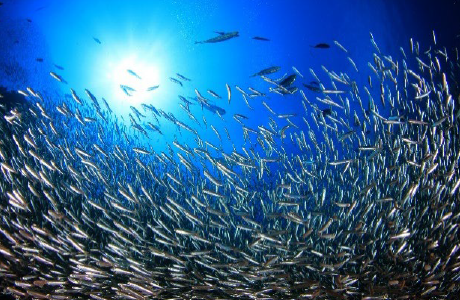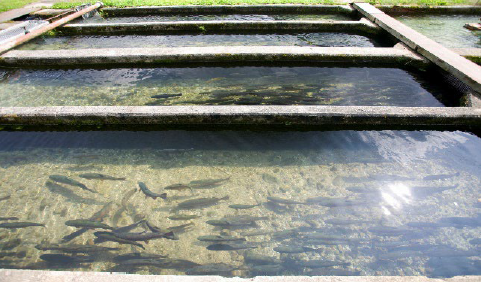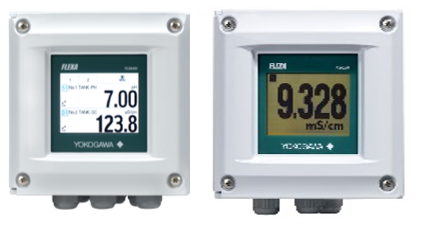Water quality determines the success or failure of an aquaculture operation. Yokogawa’s reliable pH process analyzers and sensors ensure the optimum pH for fish is controlled and maintained.
Introduction
Understanding the physical and chemical qualities of water is critical to successful aquaculture. Fish are totally dependent upon water to breathe, feed, grow, maintain a salt balance, and reproduce. Water quality determines the success or failure of an aquaculture operation.

Example: Fish Farm Nets
pH is important in aquaculture as a measure of the acidity of the water. The pH scale ranges from 1 to 14. The quantity of hydrogen ions (H+) in water will determine if it is acidic or basic. A value of 7 is considered neutral, neither acidic or basic; values below 7 are acidic; above 7, basic.
The acceptable range for fish culture is normally between pH 6.5 and 9.0. Fish will grow poorly and reproduction will be affected at consistently higher or lower pH levels.
Very high and very low pH values, respectively, greater than 9.5 and less than 4.5, are unsuitable for most aquatic organisms. Young fish and immature stages of aquatic insects are extremely sensitive to pH levels. Fish cannot survive in waters below pH 4 and above pH 11 very long (see Figure 1).
| pH | Effect on fish |
| 4 | Acid death point |
| 4 to 5 | No reproduction |
| 4 to 6.5 | Slow growth |
| 6.5 to 9 | Desirable ranges for fish reproduction |
| 9 to 10 | Slow growth |
| ≥11 | Alkaline death point |
Figure 1: The Effects of pH on Warm Water Pond Fish
Challenges
Monitoring and control of pH are critical. High pH levels (9-14) can harm fish by denaturing cellular membranes. Changes in pH can also affect aquatic life indirectly by altering other aspects of water chemistry. Low pH levels accelerate the release of metals from rocks or sediments in the stream. These metals can affect a fish’s metabolism and the ability to breathe.
At a pH greater than 9, most ammonium in water is converted to toxic ammonia (NH3), which can be fatal to fish. Moreover, cyanobacterial toxins can also significantly influence fish populations. pH is critical for the bacteria that clean the water and nitrifiers that remove excess nutrients.
Related challenges include maintenance of ammonia and alkalinity levels and buffering systems.
Ammonia
Fish excrete ammonia and lesser amounts of urea into the water as waste. Two forms of ammonia occur in aquaculture systems, ionized and unionized.
The unionized form of ammonia (NH3) is extremely toxic while the ionized form (NH4+) is not. Both forms are grouped together as "total ammonia." Through biological processes, toxic ammonia can be degraded to harmless nitrates.
In natural waters such as lakes, ammonia may never reach dangerously high levels because of the low densities of fish. However, a fish farmer must maintain high densities of fish and, therefore, runs the risk of ammonia toxicity. Unionized ammonia levels rise as temperature and pH increase (Table 1).
| pH | 12.2°C | 16.7°C | 20°C | 23.9°C | 27.8°C | 32.2°C |
| 7.0 | 0.2 | 0.3 | 0.4 | 0.5 | 0.7 | 1.0 |
| 7.4 | 0.5 | 0.7 | 1.0 | 1.3 | 1.7 | 2.4 |
| 7.8 | 1.4 | 1.8 | 2.5 | 3.2 | 4.2 | 5.7 |
| 8.2 | 3.3 | 4.5 | 5.9 | 7.7 | 11.0 | 13.2 |
| 8.6 | 7.9 | 10.6 | 13.7 | 17.3 | 21.8 | 27.7 |
| 9.0 | 17.8 | 22.9 | 28.5 | 34.4 | 41.2 | 49.0 |
| 9.2 | 35.2 | 42.7 | 50.0 | 56.9 | 63.8 | 70.8 |
| 9.6 | 57.7 | 65.2 | 71.5 | 76.8 | 81.6 | 85.9 |
| 10.0 | 68.4 | 74.8 | 79.9 | 84.0 | 87.5 | 90.6 |
Table 1: Percentage of Total Ammonia that is Unionized at Various Temperatures and pH
To determine the concentration of unionized ammonia, multiply the total ammonia concentration by the percentage that is closest to the observed temperature and pH of the water sample. For example, a total ammonia concentration of 5 ppm at pH 9 and 20°C would be:
5 ppm total ammonia X 28.5% = 1.43 ppm.
Toxicity levels for unionized ammonia depend on the individual species; however, levels below 0.02 ppm are considered safe.
Dangerously high ammonia concentrations are usually limited to water recirculation system or hauling tanks where water is continually recycled and in pond culture after phytoplankton die-offs. However, the intermediate form of ammonia--nitrite--has been known to occur at toxic levels (brown-blood disease) in fish ponds.

Example: Underwater View of Fish in Farm Nets
Buffering Systems
A buffering system is employed to avoid wide swings in pH and is essential in aquaculture. Without some means of storing carbon dioxide released from plant and animal respiration, pH levels may fluctuate in ponds from approximately 4-5 to over 10 during the day. In recirculating systems constant fish respiration can raise carbon dioxide levels high enough to interfere with oxygen intake by fish and reduces the pH of the water.
Alkalinity
Alkalinity is the capacity of water to neutralize acids without increasing pH. This parameter is a measure of the bases, bicarbonates (HCO3-), carbonates (CO3-) and, in rare instances, hydroxide (OH-). Total alkalinity is the sum of the carbonate and bicarbonate alkalinities. Some waters may contain only bicarbonate alkalinity and no carbonate alkalinity.
The carbonate buffering system is important to the fish farmer regardless of the production method. In pond production, where photosynthesis is the primary natural source of oxygen, carbonates and bicarbonates comprise a storage area for surplus carbon dioxide. By storing carbon dioxide in the buffering system, it is never a limiting factor that could reduce photosynthesis, and in turn, reduce oxygen production.
Also, the buffering system prevents wide daily pH fluctuations.
Without a buffering system, free carbon dioxide will form large amounts of a weak acid (carbonic acid) that could potentially decrease the night-time pH level to 4.5. During peak periods of photosynthesis, most of the free carbon dioxide will be consumed by the phytoplankton and, as a result, drive the pH level above 10. As described earlier, fish grow within a narrow range of pH values and either of the above extremes will be lethal.
In recirculating systems where photosynthesis is practically non-existent, a good buffering capacity can prevent excessive build-ups of carbon dioxide and lethal decreases in pH. For catfish production, it is recommended that the fish farmer maintain total alkalinity values of at least 20 ppm. Alkalinities of at least 80-100 ppm are suggested for hybrid striped bass. For water supplies that have naturally low alkalinities, agriculture lime can be added to increase the buffering capacity of the water.

Example: Open Ocean Fishing Ponds at the Coldest Nighttime Temperatures
Solution
Several factors contribute to reducing the pH in ponds. Rain is acidic, usually with a pH of 5.2 to 5.6, but industrial pollution can lower it to 2.5. In areas with coniferous forests, rain percolates through the pine needles, making it even more acidic. Over time, this leaches all the minerals out of the soil. Also, the clay bottom necessary to keep a pond from leaking is acidic, and decaying plants can release additional acids. Agricultural lime or crushed limestone (calcium carbonate) will neutralize these acids and form a buffer to keep the pH from changing rapidly.
Rapid changes in pH, even within an otherwise survivable range, can be fatal to fish. While they can adjust their body chemistries as pH changes in the environment, this takes energy, which could instead used for growth and reproduction. Maintaining a constant internal pH in an extreme environment causes stress, making the fish susceptible to disease and parasites.

Example: A Trout Fish Farm
In a limed pond, phosphorus from fertilizer is in the soluble, orthophosphate form that plankton can use; other forms settle at the bottom. Finally, liming can increase the amount of carbon dioxide in water, which is used in photosynthesis. For these reasons, liming ponds has been shown to double bluegill production in ponds, without adding any fertilizer.
Summary
Measurement points: In tank
Typical problems: Installation of the pH sensor at an appropriate location
Remedies: Using an immersion fitting with support for 2” pipe mounting accessories
pH can be measured using Yokogawa's 2-wire/4-wire pH Analyzer with a suitable immersion fitting and sensor.
Cleaning: Simply remove the pH sensor, clean the sensor following provided instructions and re-install it.
Benefit: The pH sensor uses double junction electrodes, which provide long time stability and durability.
More reliable and accurate pH analysis enables improvements to the end product quality.
Product Selection
 Process Liquid Analyzer:
Process Liquid Analyzer:
2-wire 24 VDC Loop-powered FLXA202 Analyzer
4-wire AC/DC Line powered FLXA402 Analyzer
Features:
- Dual sensor measurement on a 2-wire or 4-wire analyzer
- Indication of sensor health status
- Simple touchscreen operation
- Trending display up to 2 weeks
- Advanced process temperature compensation
Sensor Selection:
Analog and Digital SMART sensors are available. Analog options allow users to interface with a traditional system. SENCOM™ technology allows sensors to transmit and receive data when connected to a transmitter/analyzer or any PC. The SMART digital sensors maintain sensor-specific measurement and calibration data on an integrated circuit to provide easy plug-and-play solutions. The data management software optimizes sensor performance for enhanced reliability and process safety. pH immersion fitting (such as FD20 series or equivalent) with FU20 pH sensor.

Features:
The FU20 combination sensor applies Yokogawa’s “Simply the Best” technology. The wide-body sensors (26 mm diameter) hold four separate measurement elements in one unbreakable and chemically resistant PPS 40GF (RytonTM) body. The integrated industrial 3/4” tapered thread simplifies installation. Temperature fluctuations are compensated to extend the sensor life.
Digital SMART Option:
The re-usable smart adapter, SA11, offers full measurement parameter functionality for analog sensors equipped with a Variopin connector and Yokogawa ID chip. The SA11 automatically recognizes the installed sensor and prepares the appropriate configuration.

Industries
-
Food & Beverage
The food and beverage industry must produce safe, high-quality foods and beverages for consumers. In addition to quality control, the manufacturing processes include many challenges such as managing ingredients, improving efficiency and handling global environmental issues. Yokogawa leverages its decades of technological expertise to help customers build and operate the ideal factory.
-
Industrial Water
Industrial water is essential for power generation, refineries, and petrochemical plants. Our measurement and control solutions for water and wastewater seamlessly integrate with main processes.
-
Wastewater Treatment
The goal of waste water treatment is to produce treated water that meets environmental regulations and can be safely released into bodies of water or reused for purposes like irrigation or industrial processes.
-
Water & Wastewater
All water, regardless of its source, has value. However, with water resources being finite, a focus on "One Water" is necessary to maximize every drop within the water system, ensuring a stable supply of clean and safe water. As we consider current and future needs, planning and implementation are critical for long-term resilience and reliability, meeting both community and ecosystem demands. Yokogawa believes water is a human right for all. Thus, contributing to a sustainable water cycle is one of our Sustainable Development Goals (SDGs).
Related Products & Solutions
-
2-Wire Transmitter/Analyzer FLXA202
Most flexible two-wire analyzer available
-
2-Wire Transmitter/Analyzer FLXA21
The FLEXA™ series analyzers are used for continuous on-line measurements in industrial installations. With an option for single or dual sensor measurement, they are the most flexible two-wire analyzer available.
-
All-in-One pH/ORP Sensor Series FU20 and FU24
The FU20 and FU24, all-in-one pH and ORP, sensors show how Yokogawa applies the motto "Simple is best" to sensor technology.
-
Digital SMART SENCOM™ Adapter, SA11
Reusable SMART adapter, requiring only the analog sensor to be disposed of when it reaches the end of its lifetime. With the SENCOM 4.0 platform, Yokogawa delivers reduced costs and waste while contributing to its long-term business goals of a sustainable future for all.
-
Immersion Holder FD20
The immersion fittings are designed for either pH or ORP (Redox) measurements in tanks, open vessels and drains. They have a "hoisting cable" for easy maintenance.
-
Multi Channel 4-Wire Analyzer FLXA402
Available in single or multi-sensor measurement
-
pH and ORP Analyzers
Optimize field maintenance, calibration, and system configuration
-
SENCOM™ SMART Digital Sensors
Reduce configuration time and simplify maintenance
Have Questions?
Contact a Yokogawa Expert to learn how we can help you solve your challenges.